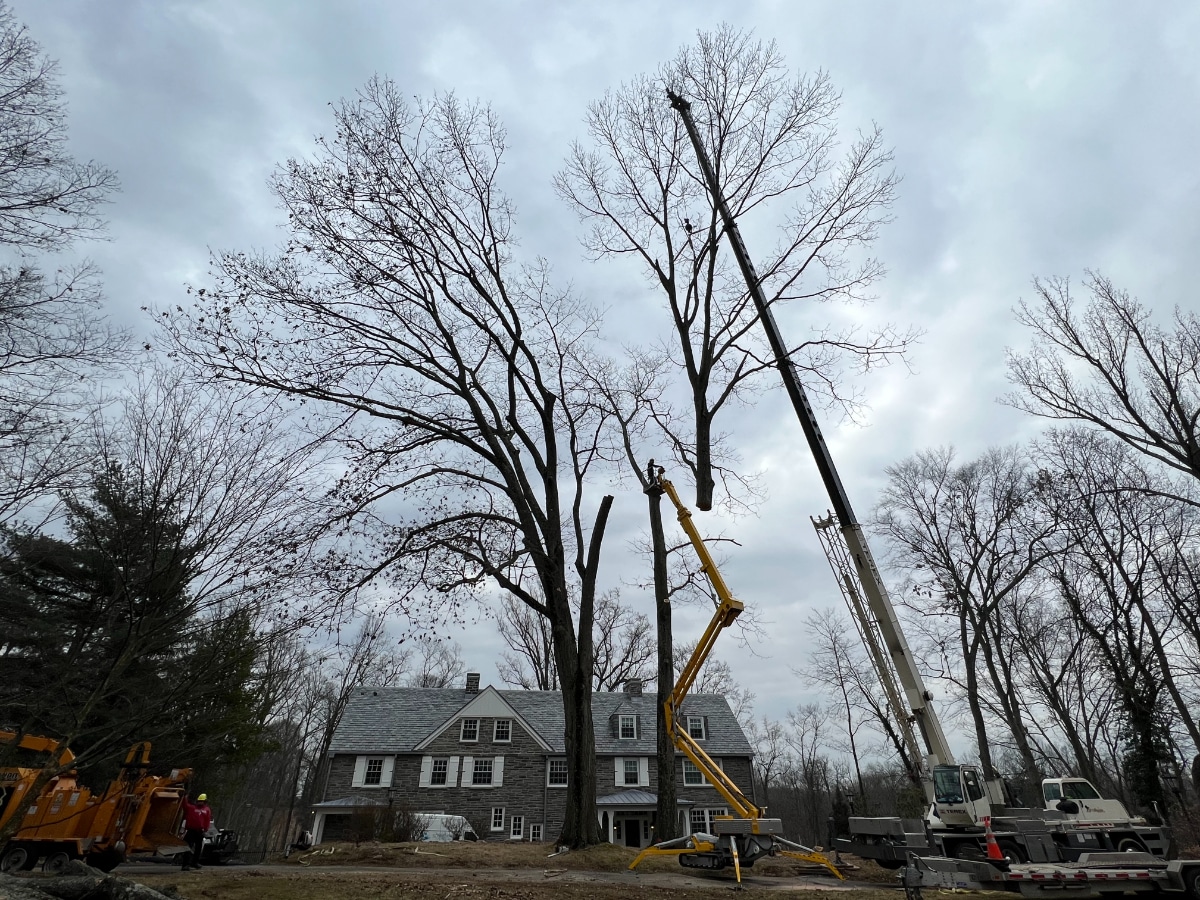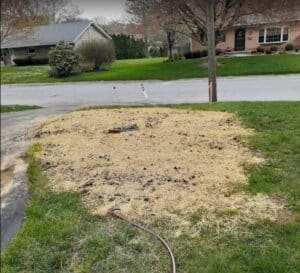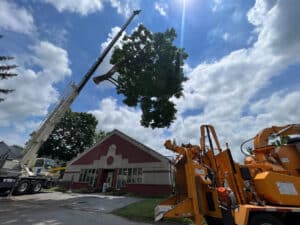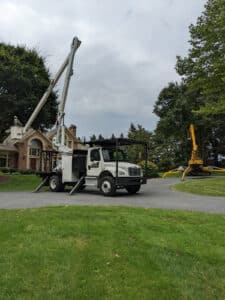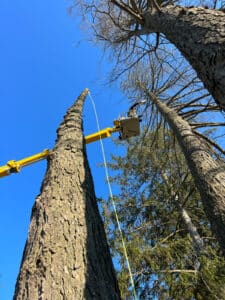Quick Takeaways
- Leaning trees, missing bark, and cracked soil around the base of the tree are red flags that a tree may fall soon.
- Root rot, soft spots, or mushrooms growing near the trunk often mean the tree’s roots are compromised and the structure is weakening.
- Acting early can prevent property damage and keep your family safe. Call a professional tree service near you if you notice these warning signs.
If you’ve ever looked out your window after a storm and noticed a leaning tree or a patch of cracked soil near its roots, you know the uneasy feeling that follows. A falling tree can destroy property and cause serious danger, but the truth is, trees usually give plenty of warning signs before that happens.
At Sunny Slope Tree Service, we’ve inspected thousands of trees across Lancaster County and have seen everything from slight leaning trunks to complete root failure. Here’s how to tell if a tree is about to fall and what you can do before it becomes an emergency.
Common Warning Signs a Tree May Fall
1. Leaning or Tilting Trees
A leaning tree isn’t automatically a goner, but it’s a sign you shouldn’t ignore. If the tree’s lean seems new or is worsening over time, that’s a clear sign the tree’s roots may be compromised. The tree’s base may be shifting after strong winds or saturated soil, putting extra pressure on one side. Isaac, from our team, explains that leaning trees close to homes are among the most dangerous: we’ve seen entire trees topple overnight after storms because their roots simply couldn’t hold on.
2. Cracked or Uplifted Soil Around the Base
Check the soil around your tree’s base. If you notice cracks, bulges, or uneven ground, it could mean the roots are pulling free underground. This happens when the root zone weakens from rot, wind or root damage, or simply old age. Once a tree loses stability in its root system, it can fall without warning.
3. Deep Cracks or Splits in the Trunk
Visible cracks or hollow spots in the tree trunk are structural issues that can worsen with every gust of wind. Over time, these weak points make the tree prone to splitting or breaking apart. Even what looks like solid wood on the outside can hide internal decay. If you can see into a hollow cavity or notice soft spots when tapping the trunk, call a professional tree service before the problem spreads.
4. Missing or Peeling Bark
Bark falling off the trunk is more than just cosmetic damage, it’s a sign that the tree’s health is in decline. Missing bark exposes the inner wood to moisture, insects, and fungus, which can trap moisture and speed up decay.
5. Root Rot, Fungus, or Mushrooms Growing Near the Base
If you see mushrooms growing around the roots or at the base of the tree, it likely means decay has taken hold underground. Root rot weakens the entire structure from beneath the surface, even if the rest of the tree still looks strong.
You might also notice a musty smell, spongy soil, or fungus climbing up the trunk. These are signs the roots are deteriorating and the tree could fall.
6. Dead or Dying Branches
Dead branches often mean the tree is struggling to send water and nutrients throughout its system. You may notice brittle limbs, falling branches after light wind, or entire sections of the canopy turning brown. If you spot dead tree branches near the top or sides, the entire tree could be dying from the inside out.
These branches can fall unexpectedly, putting property and people at risk.
7. Insects and Other Pests
Insect infestation is another danger sign. Carpenter ants, beetles, and other insects burrow into weak or dying wood. They speed up decay, making the tree hollow and unstable. Look for small holes in the trunk, sawdust near the base, or peeling bark caused by nesting insects.
Why Waiting Makes Things Worse
A weak tree rarely gets better on its own. Once decay sets in, the structure deteriorates quickly. Isaac mentioned that trees close to homes with visible rot or fungal infection are the most dangerous, especially tall trees exposed to strong winds. Delaying removal doesn’t usually save money either. A tree that’s been dead for years becomes brittle, which makes the job riskier and sometimes more costly for a crew to handle safely.
A Real Example from Lancaster County
One of the scariest situations we’ve handled was a huge oak tree leaning heavily over a customer’s home. The trunk had started splitting, and the root zone was cracking open. If the homeowner had waited another week, that tree would have fallen straight through their roof. Our team took it down safely, but it’s a perfect example of how fast conditions can change once roots are compromised.
How to Keep Trees Healthy and Worth Saving
Not every leaning tree or patch of missing bark means removal is necessary. With proper care and pruning, some trees can recover. Trimming dying branches, controlling vines, and avoiding improper pruning can help keep trees healthy longer. But if you notice multiple warning signs at once—like exposed roots, fungus, and cracked soil—it’s time to get a professional opinion.

When to Call a Professional Tree Service
If you’re unsure whether a tree on your property is safe, we can help. Sunny Slope Tree Service offers inspections and tree removal across Lancaster County and nearby areas. We’ll assess the tree’s health, check the trunk and root zone, and give you an honest answer about whether the tree is safe to keep or needs to come down. A quick visit today could prevent major storm damage tomorrow.
Call Sunny Slope Tree Service For A Safer Property!
If you’ve noticed any of these warning signs—leaning trees, peeling bark, or dead branches—don’t wait for the next storm to decide for you. Call Sunny Slope Tree Service for a professional tree service inspection near you.
We’ll make sure your trees are safe, your property is protected, and your peace of mind stays intact.
FAQs
How do you know when a tree is going to fall?
If a tree leans suddenly, loses large patches of bark, or has cracked soil around the roots, it may be on the verge of falling.
Can a leaning tree be saved?
Sometimes. If the tree’s lean is slight and the roots are still solid, it may be stabilized with support cables. But if root damage or decay is present, removal is often safest.
Are mushrooms growing around a tree always bad?
Yes, mushrooms mean fungus is feeding on decaying wood. It’s a sign of root rot or internal breakdown.
Should I worry about falling branches?
Yes. Falling branches are early indicators of deeper issues in the trunk or root system, especially in older trees.

